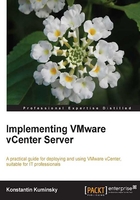
Summary
vCenter is a tool for the centralized management of the vSphere suite. It allows the management of multiple ESX/ESXi servers and VMs through a single-console application.
The VMware software stack consists of three layers: virtualization, management, and interface layers.
vCenter Server comes in two editions: Standard and Foundation. Foundation is designed for small- and middle-sized environments and is able to manage up to three hosts. Standard edition is for large vSphere deployments.
vCenter deployment consists of the following tasks:
- Setting up vCenter Server databases.
- Installing vCenter Server and vCenter Server support tools. Then connect to vCenter Server from the vSphere Client or the vSphere Web Client.
- As an optional step, creating a Linked Mode group or joining vCenter Server to a Linked Mode group.
Before starting vCenter deployment, you need to make sure that all prerequisites and requirements are met.
There are two approaches to the deployment of vCenter Server: it can be deployed on a virtual server or on a physical server.
Virtual machines are easier to manage; so, in other words, you get all the advantages related to virtualization while deploying vCenter on a virtual server.
On the other hand, running virtualized vCenter has certain concerns.
A Linked Mode group is a group of vCenter servers. It allows administrators to connect to one of them and manage inventories from all vCenter Servers in the group.